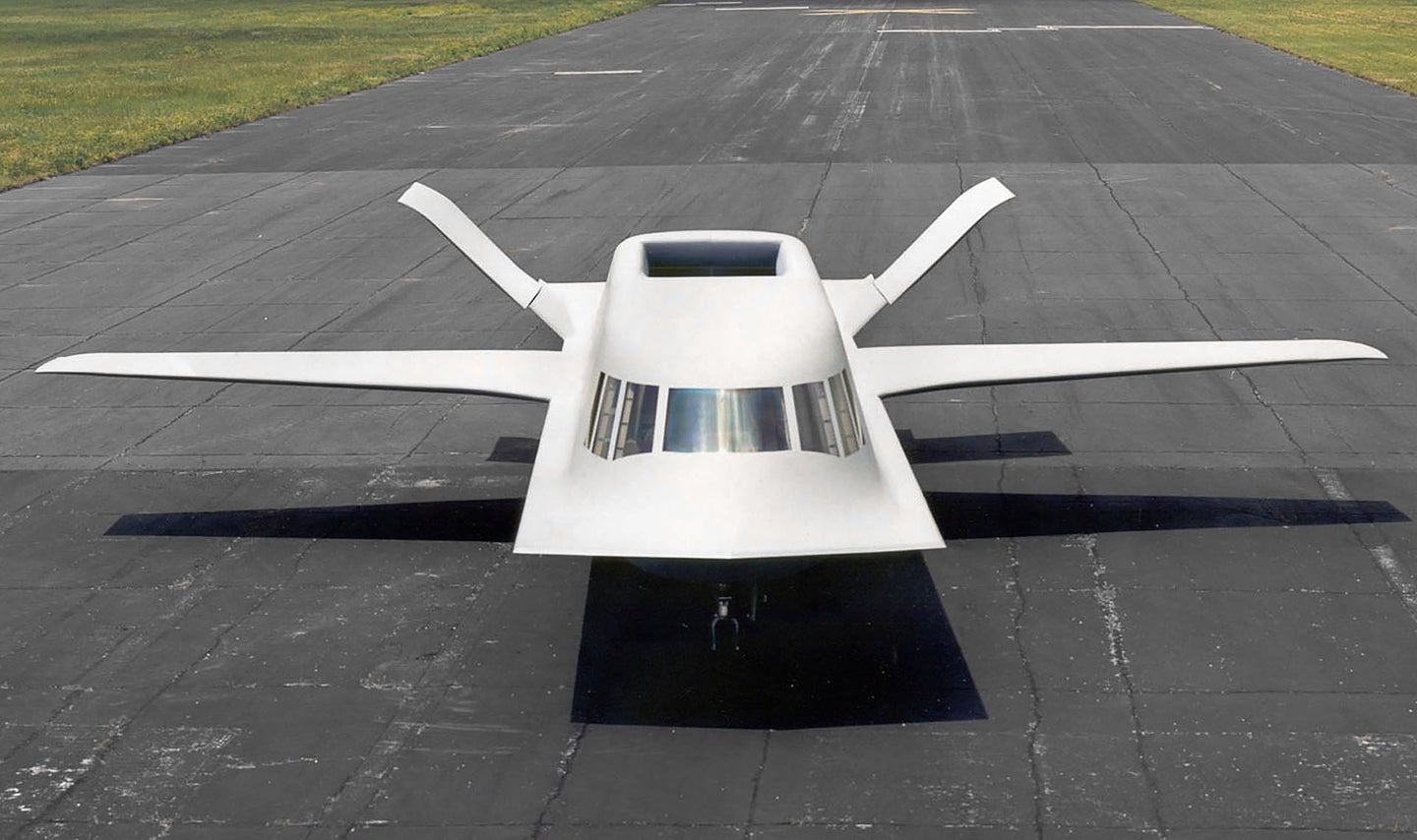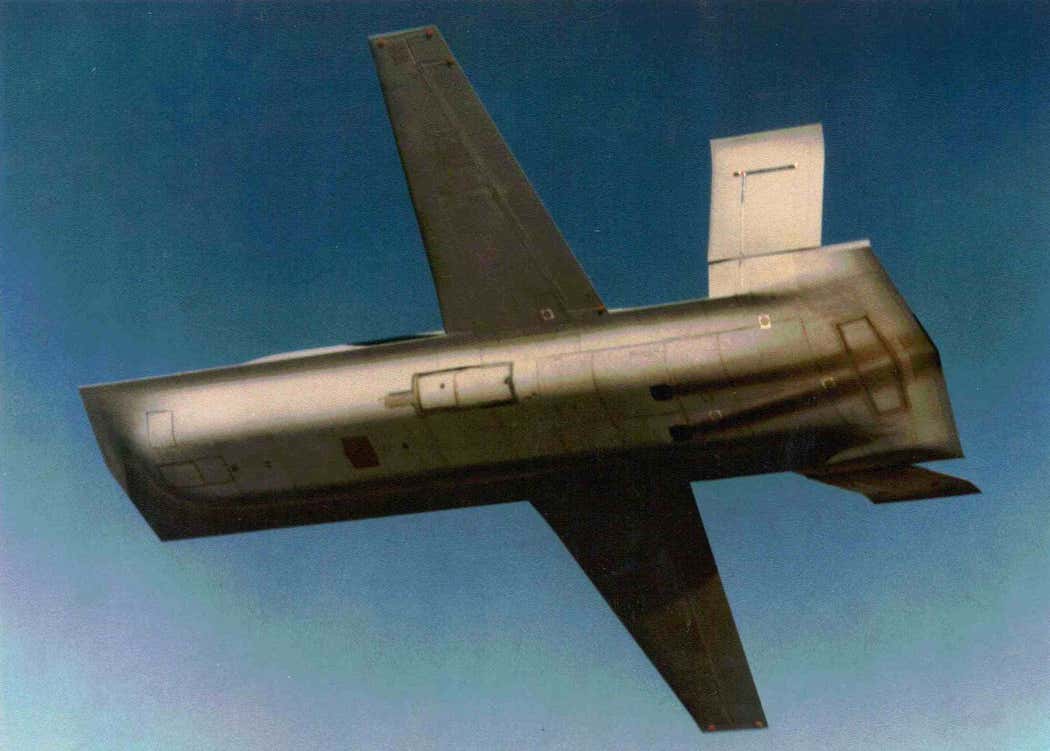
Northrop's "Whale" stealth battlefield surveillance jet was revolutionary. Now we get a better look into the program from someone who was there.
The fantastic 10 Percent True YouTube channel, the creation of Steve Davies, recently had Denny Jarvi on as a guest. Jarvi was an accomplished U.S. Air Force fighter pilot that found himself descending into the shadowy black projects world in the early 1980s to help run the top-secret Battlefield Surveillance Aircraft-Experimental (BSAX) demonstrator program, better known as Tacit Blue. In the interview, Jarvi gives a frank account of many of the finer details of what is understood to have been one of the most transformational secret aircraft test programs in known history, although it is often overshadowed by Lockheed's Have Blue stealth demonstrator that came before it.
Northrop's
“Whale” demonstrator, the centerpiece of the Tacit Blue program, is
maybe most famous for its absolutely homely looks. “Wow, haha, this is
not the prettiest machine I’ve ever seen,” was Jarvi's first impression
of the aircraft after setting eyes on it. Yet it was a product of the
early days of the stealth revolution, which broke all traditions when it
came to what a combat aircraft should look like.
Tacit Blue aimed to prove that a surveillance aircraft could persist for long periods of time over the front lines of the battlefield while collecting very high-fidelity intelligence and survive to repeat the task the next day. This was a huge departure from past spy aircraft like the SR-71, which basically took a snapshot in time. With the help of stealth technology and highly tailored sensors and communications systems, Tacit Blue proved that an aircraft could deliver what would be akin to a constant feed of near real-time intelligence over or very near the most hostile places on earth. It was like going from taking a Polaroid picture at a birthday party to filming the entire party without anyone even knowing you were there. Simply put, Tacit Blue's success represented a quantum leap in how intelligence could be gathered from the air and its accomplishments still reverberate throughout the U.S. military today.
The video is well worth a watch in its entirety. Jarvi's recollections are highly interesting and they help add color to what is, unfortunately, something of an obscure footnote in military aviation history.
With that being said, here are some of the major takeaways from Jarvi's discussion with Davies:
- While just one Tacit Blue "Whale" flew, there was another non-completed airframe in reserve just in case the first prototype was lost. Jarvi thinks this second airframe was likely destroyed after the program was shuttered.
- The first airframe was trucked from Northrop's Hawthorne plant to Area 51 in partially assembled form.
- Tacit Blue was tested against an F-15 with its powerful AN/APG-63 radar and with a test pilot at the controls. The Eagle never saw the Whale on radar, at least until it was well within visual range.
- No other airplane detected Tacit Blue via its own RF emissions during testing despite it having a powerful radar and datalink system onboard. The Low Probability of Intercept (LPI) tactics employed by those systems worked to keep the aircraft concealed while flying very near threat systems and actively emitting RF energy.
- Tacit Blue's notional concept of operations involved flying over or very near the forward edge of the battlefield at around 25,000-30,000 feet and orbiting overhead at 250 knots or so while its radar scanned the area below.

- The entire concept was meant to provide real-time reconnaissance on the movement of Soviet armor crossing into Western Europe, most notably around the Fulda Gap. Obviously, the same capability could have been useful for other mission sets post-Cold War.
- 135 sorties were flown, sometimes two sorties per day, but always during the daytime. The aircraft flew out of Area 51 and there were no mishaps during the program.
- The Hughes LPI radar with Ground-Moving Target Indicator (GMTI) capability measured three feet high by seven feet long.
- While the Tacit Blue demonstrator only had the radar on one side, if the aircraft were to have been refined for production, it would have had another array on the other side, as well.
- Multiple accounts state the aircraft was the most unstable ever flown at the time. It was so unstable, in fact, that it would end up being pointed backward in the wind tunnel during testing. It used an F/A-18's fly-by-wire flight control system to overcome its lack of stability.

- There was a "brick wall" between Northrop and Lockheed and what each knew about stealth technology at the time. This isn't new, but it is interesting that it continued on even as the F-117 was put into production. The fact that the Advanced Technology Bomber contract was underway certainly would have influenced this reality, as well. But even then, stealth capabilities were largely viewed as proprietary corporate technology.
- While the aircraft's existence was known by a relatively small number of people, far fewer knew its performance in terms of low-observable capabilities, which was outstanding.
- During a radar cross-section pole test of a scale model of the Whale, radar technicians couldn't figure out why it was so visible compared to the projections. Turns out an owl hand landed on it. Even during flight testing, small differences in the aircraft's signature resulted in crews pouring over every inch of the plane to see if something was out of place, like a panel or a piece of radar absorbent material (RAM).

- The program had a very small chain of command, which allowed them to do whatever they needed as long as it "didn't break federal law." The DARPA program at one time was managed from an anonymous office called XRJ at Wright Patterson AFB, but it largely reported to high-up officials at the Pentagon, including General Wilbur Creech, then the head of Tactical Air Command. William Perry was also a champion of the program, at least early on.
- General Creech was bullish on the Tacit Blue concept but was worried that a stray MiG returning from a cross-enemy-lines combat mission could stumble upon it by happenstance, visually acquiring it and shooting it down. Lighting and various camouflage were evaluated to help with visual stealth, but they did not have a solution for close visual encounters.
- Tacit Blue's radar was nearly good enough to tell what type of vehicles it was detecting on the ground. This is quite an accomplishment for the era. More fine-tuning and the application of other advances would have allowed it to do that and much more.

- Standoff radar-carrying aircraft that were anything but stealthy may have been able to survive over 100 miles or more away from the front lines, but their radar's view of the battlefield would have been partially obstructed by terrain. Tacit Blue could look nearly straight down, where ground clutter and the shadows caused by hills and structures were not a factor.
- The aircraft's Low Probability of Intercept datalink was one-way, feeding radar intelligence to ground stations.
- The idea is that Tacit Blue could have gone into production, creating a small number of evolved Whale aircraft that could execute the mission. One issue was that the data it gathered was so good, those not read into the program would have wondered where it was coming from. While the B-2 was so big it would have to be disclosed, an operational fleet of Tacit Blue aircraft wouldn't have been. But how do you use it without giving away that it exists? This was an early debate regarding a potential production aircraft's concept of operations.
- Infrared signature reduction was a big part of the design, with the deeply buried, dorsal inlet-fed twin Garrett ATF3 turbofan jet engines having a serpentine exhaust. This allowed the air to cool before exiting the aircraft and a specially treated 'platypus' tail allowed it to be cooled even more before leaving the confines of the aircraft's planform. The duct and tail arrangement reduced thrust, but it was an easy trade considering the mission set the aircraft was designed to achieve.

- The acoustic signature of the aircraft was also fairly low, with its engines being quiet by default, at least to the point that if people were working below or going about their lives around others they probably wouldn't notice it up at 25,000-30,000 feet.
- A large part of the Tacit Blue program was coming up with the concept of operations in regards to how an operational version of it could be used in battle.
- The program was ended in May of 1984, but its findings could have been passed on to another secret program Jarvi says, but he doesn't know anything about that—"who knows what took its place."
- Some of the Tacit Blue program remains classified to this very day.
Once again, these were just some of the most interesting points in Davies' interview, and you should watch the whole thing in full. If you want to know what it was like flying the Whale, check out this previous piece of ours.

The Whale's exotic design was very much a harbinger of what was to come in terms of stealth technology. Its continuously curving surfaces, buried engines with serpentine ducts and platypus exhausts, widely splayed v-tail, and pronounced chine lines not only were adopted by the YF-23, and to a large degree, the B-2, but to this very day, low-observable designs leverage these same features. In fact, even very modern aircraft and cruise missile configurations can look stunningly like the Whale. Still, it could be argued that some of those features were at least notionally established before Tacit Blue, but nobody had flown a manned aircraft that put them all together, let alone one that could carry big and powerful radar.
In the years and decades that followed the Tacit Blue program, bolstered by more powerful computing and a better understanding of stealth technology, even Lockheed's original faceted stealth concept gave way to the much more Whale-like ever-morphing curvilinear designs.
I believe it is very possible that something did come after Tacit Blue. A missing link between what the program proved in terms of the potential that penetrating and persistent aerial reconnaissance through stealth technology showed and the drones that followed later to accomplish a similar mission, albeit updated dramatically for the post-Cold War era. You can read more about that here.
Maybe the biggest tribute to Tacit Blue could emerge on the horizon nearly 40 years after the Whale first flew. While the Pave Mover program did produce the E-8 JSTARS radar aircraft, that mission is likely going to be handed over to a distributed network of stealthy drones as converted airliners won't be able to get safely within the distance of target areas for their radars to even be effective during a peer-state conflict, nor can they be as effective even if they could. The likely centerpiece of such a capability is the still-in-the-shadows "RQ-180." This is a very stealthy, high-flying aircraft that can penetrate and persist in highly contested airspace while executing a similar, albeit far more advanced mission to that of Tacit Blue, one adapted for a new era of peer-state tensions. It is also almost certainly a Northrop Grumman product. You can read my full take on this aircraft here.
To think that it all began on the bleeding edge of what was possible, out in the desolate expanse of Area 51 and in the bustling halls of Northrop, the Pentagon, and Wright Patterson AFB, among other locales, nearly four decades ago, thanks to highly dedicated and talented people like Denny Jarvi.
Tyler Rogoway
No comments:
Post a Comment
Note: Only a member of this blog may post a comment.